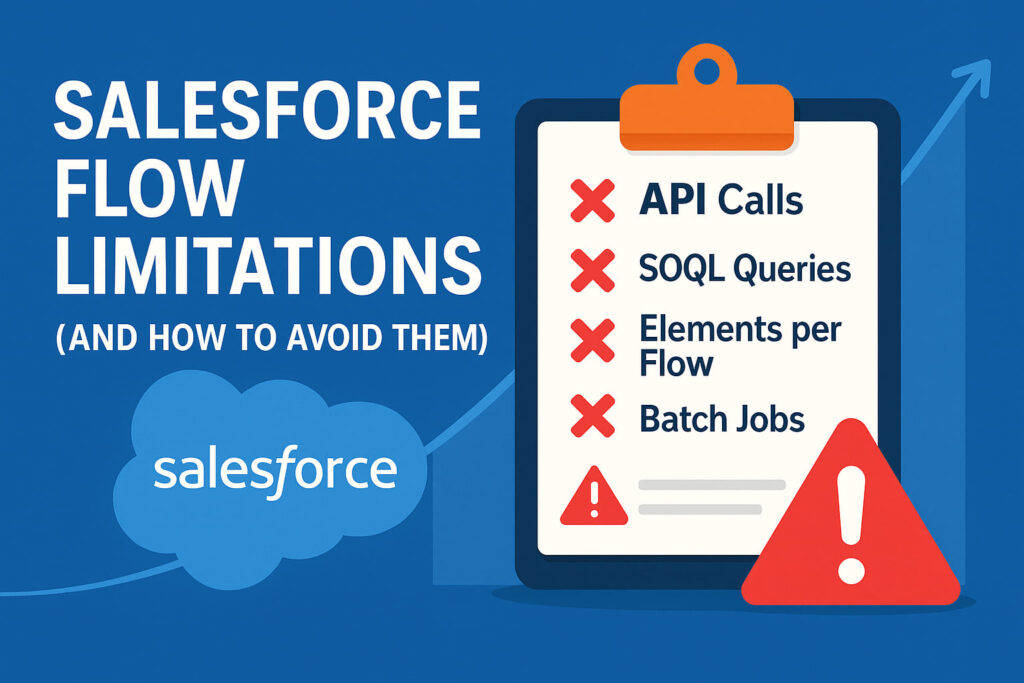Salesforce Flow Limitations (and How to Avoid Them)
Salesforce Flow Limitations are the technical and transactional constraints that control how many elements, database operations, and resources a Flow can use during execution.
These limits prevent system overloads by enforcing boundaries for DML operations, SOQL queries, CPU time, and transaction size in automation processes.
Understanding Salesforce Flow Limitations
Salesforce Flow is one of the most advanced automation frameworks within the Salesforce ecosystem. It allows admins and developers to build declarative logic that executes record updates, validation, calculations, and cross-object interactions — all without writing code. However, beneath its drag-and-drop simplicity lies the same technical engine that governs Apex execution, and with it come Salesforce governor limits.
These limitations aren’t bugs or design flaws. They’re intentional guardrails that maintain platform stability across a shared multi-tenant architecture. Every Flow, whether record-triggered, scheduled, or autolaunched, consumes a portion of the system’s compute resources: database transactions, CPU cycles, heap memory, and API bandwidth. When those resources exceed defined thresholds, the Flow fails to protect the integrity of the Salesforce org.
In short — Flow runs inside the same transaction context as Apex, which means it shares the same resource boundaries. Mismanaging one complex automation can disrupt hundreds of parallel operations. That’s why understanding and optimizing Flow limitations isn’t optional — it’s mandatory for scalable deployment.

Key Flow Limit Categories
| Type | Description | Limit |
|---|---|---|
| DML Operations | Database write operations, such as Create, Update, Delete. | Max 150 per transaction |
| SOQL Queries | Database read operations. Each “Get Records” element consumes one query. | Max 100 per transaction |
| Executed Elements | Each element that executes (Assignment, Decision, Screen, etc.). | Max 2,000 per transaction |
| CPU Time | Time allocated for code and Flow execution before timeout. | Max 10,000 ms |
| Heap Size | Memory space for variable storage and collections. | Max 6 MB |
When combined, these limits define the runtime sandbox of a Flow — the virtual cell it can’t break out of.
Every node, loop, and data element consumes measurable cost. Complex automations with nested logic or multiple decision branches may quickly cross thresholds even on medium-sized data sets.
Architectural Example
Let’s imagine an After-Save Record-Triggered Flow that runs on Opportunity updates. The Flow retrieves related Quote records, loops through them, recalculates totals, and updates pricing.
For a single Opportunity with ten related Quotes, this is fine. But if a mass update triggers hundreds of Opportunities — you instantly hit:
- 100+ SOQL queries (for “Get Records” per loop iteration),
- over 150 DML statements (“Update Records” per Quote),
- and likely CPU exhaustion within seconds.
The result:
System.LimitException: Too many SOQL queries: 101
That’s not an error — it’s a message from the system saying:
“You built a Flow like a champ but deployed it like a fool.”
Governor Mechanics Explained
Every Flow execution starts a governed transaction. Inside that transaction:
- Each DML or SOQL is counted globally, not per element.
- Nested subflows share the same transaction context.
- Screen Flows reset limits when resumed (new transaction).
- Scheduled Flows often run asynchronously, isolating their resource footprint.
When the Flow hits a boundary — execution halts. There’s no partial success, no rollback confirmation. Unless you’ve architected for it, you lose consistency across objects.
How Metadata API Helps Here
During development, metadata API allows automated validation and deployment testing of Flows. You can:
- Detect invalid references or misconfigured variables.
- Simulate Flow execution using test data contexts.
- Roll back failed deployments automatically, ensuring no half-migrated logic hits production.
This is especially critical in CI/CD pipelines where Flows are versioned and deployed alongside Apex classes. Using metadata API validation reduces the chance of runtime limit breaches during deployment.
Why It Matters for Scalability
If your org processes high-volume data — like order updates, case management, or lead assignment — governor limits multiply their impact exponentially. Each misconfigured Flow can cause cascading failures across automation layers, leading to incomplete record updates, stuck transactions, and unexpected rollbacks.
Building scalable Flows means treating them like software components:
- Plan logic with a flowchart before designing in the builder.
- Simulate data load scenarios using sandbox environments.
- Measure CPU and query consumption in debug logs.
- Deploy through validated metadata, not manual copy-paste.
When you do that, Flow becomes not a bottleneck — but a reliable, reusable automation asset.
Example: A properly optimized Flow using collection assignments, subflows, and decision elements can process 10,000+ records without exceeding any limit, while an unoptimized version may fail after just 500.
FAQ — People Also Ask
What are the limitations of using Salesforce Flow?
Flows are limited by DML operations, SOQL queries, CPU time, and transaction size.
How to fix Flow limit exceeded in Salesforce?
Use Subflows, Apex extensions, and asynchronous processing.
Why do we need flows in Salesforce?
Flows automate business logic visually, reducing dependency on code and simplifying deployment.
What’s the difference between Workflow and Flow?
Workflow is a legacy automation tool; Flow is a modern, flexible runtime supporting advanced logic and record-triggered automation.
Conclusion
Salesforce Flow gives you power — but without control, that power backfires.
Respect the limits, monitor execution, and offload heavy logic into Apex when necessary.
With proper architecture and validation through metadata API, you’ll build automations that scale safely and deploy seamlessly.
Need expert help? Contact us via our Contact Page — we’ll help you design Flow solutions that stay efficient and stable.
For more technical depth, check out Salesforce Developer Docs for up-to-date API and Flow configuration guidance.